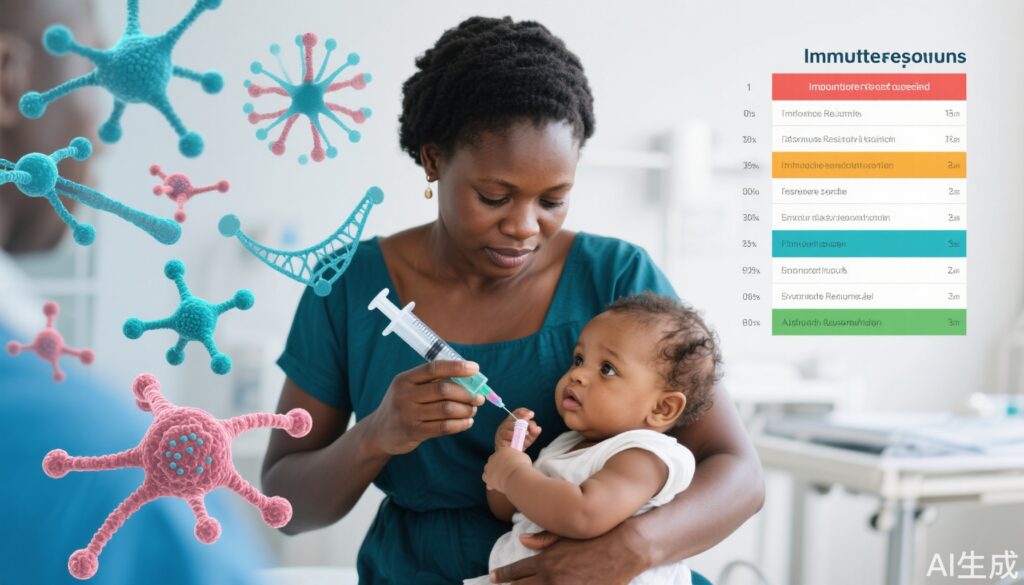Highlights
- Maternal Tdap-IPV vaccination in pregnancy was safe and well tolerated in a West African setting.
- Maternal immunization boosted early pertussis-specific antibodies in infants but blunted responses to subsequent infant whole-cell pertussis (DTwP) vaccination more than acellular (DTaP) vaccination.
- Despite blunting, DTwP-vaccinated infants maintained overall strong immune responses, with no safety concerns identified.
- Findings inform infant vaccine strategy in low- and middle-income countries relying on DTwP-based immunization schedules.
Clinical Background and Disease Burden
Pertussis (whooping cough) remains a significant cause of morbidity and mortality in young infants globally, especially in low- and middle-income countries. Infants are most vulnerable before completing their primary vaccine series. Immunizing women during pregnancy with pertussis-containing vaccines (such as Tdap-IPV) is a proven strategy to transfer protective antibodies to the fetus, reducing severe disease and death in the neonatal period. However, there is concern that high levels of maternally derived antibodies might attenuate (“blunt”) the infant’s immune response to their own primary pertussis vaccinations, particularly in settings where whole-cell pertussis vaccines (DTwP) are used. Understanding this interaction is essential for optimizing immunization strategies in resource-limited settings.
Research Methodology
The Gambian Pertussis Study (GaPS) was a randomized, controlled, double-blind, phase 4 trial (ClinicalTrials.gov: NCT03606096) conducted at a single site in The Gambia. Healthy, HIV-negative pregnant women (n=343 maternal-infant pairs) were randomized (1:1) to receive either Tdap-IPV (tetanus-diphtheria-acellular pertussis-inactivated polio vaccine) or tetanus toxoid (TT) vaccine at 28–34 weeks’ gestation. Their infants were also randomized (1:1) to receive either DTaP or DTwP at 8, 12, and 16 weeks postnatal age. The primary endpoint was the geometric mean concentration (GMC) of infant pertussis toxin-specific IgG antibodies at 20 weeks and 9 months. Secondary and exploratory outcomes included memory B-cell responses, total pertussis-specific antibody binding, functional antibody assays (pertussis toxin-specific neutralizing activity [PTNA], serum bactericidal activity [SBA]), and vaccine reactogenicity.
Key Findings
Of 343 enrolled pairs, 239 infants were included in the per-protocol immunogenicity analysis. The principal findings were:
– Among infants whose mothers received Tdap-IPV, anti-pertussis toxin IgG GMCs at 20 weeks were over threefold lower in those vaccinated with DTwP compared to DTaP (adjusted geometric mean ratio 0.28, 98.75% CI 0.16–0.50), and this difference persisted at 9 months.
– In infants of TT-immunized mothers, post-primary vaccination GMCs of anti-pertussis toxin IgG at 9 months were higher in DTwP than DTaP recipients (GMR 2.02, 1.15–3.55).
– Maternal Tdap-IPV blunted anti-pertussis toxin IgG responses to primary vaccination in all infants, but the effect was most pronounced in DTwP recipients. For example, at 20 weeks, DTwP-vaccinated infants born to Tdap-IPV mothers had eightfold lower GMCs than those born to TT mothers (GMR 0.12, 0.07–0.22).
– Blunting was also seen in PTNA, SBA, total pertussis-specific antibody binding, and memory B-cell responses in DTwP-vaccinated infants born to Tdap-IPV mothers; minimal blunting was observed among DTaP-vaccinated infants.
– Importantly, despite blunting, the absolute immune responses generated by DTwP-vaccinated infants were similar to or higher than those in DTaP-vaccinated infants.
– Reactogenicity was mild (grades 0–1) and similar between Tdap-IPV and TT maternal vaccine groups, with no serious vaccine-related adverse events.
00072-6/asset/90e90407-06ca-46bc-812a-3a7ae5dbecef/main.assets/gr3.jpg)
Mechanistic Insights and Biological Plausibility
Blunting of vaccine-induced antibody responses by maternal antibodies is a recognized immunological phenomenon. Maternal antibodies can neutralize vaccine antigens or mask epitopes, resulting in reduced B-cell activation in the infant. However, the clinical significance of blunted serological responses remains debated—especially when absolute antibody levels remain above protective thresholds and immunological memory is preserved. The preservation of memory B-cell responses and functional antibody activity in this trial suggests that maternal vaccination does not compromise long-term infant immunity, even in settings relying on DTwP.
Expert Commentary
These data are consistent with prior studies in high-income settings using DTaP, but provide important new evidence for whole-cell pertussis vaccines, still widely used in Africa and Asia. The findings support the safety and early protective benefit of maternal Tdap-IPV, while acknowledging transient reductions in some infant immune responses. Current WHO and national guidelines endorse maternal pertussis immunization based on strong evidence of reduced infant morbidity and mortality.
Controversies and Limitations
– The trial was conducted at a single center, potentially limiting generalizability to other settings.
– Only healthy, HIV-negative women were included; results may differ in populations with higher HIV prevalence or comorbidities.
– The clinical relevance of blunted antibody responses—especially in relation to protection against pertussis disease—remains uncertain, as correlates of protection are not fully established for pertussis.
– Longer-term follow-up would be valuable to assess the durability of immune memory and responses to booster doses.
Conclusion
Maternal Tdap-IPV vaccination in pregnancy is safe and confers robust early protection to infants, even in a low-resource, sub-Saharan African context. While it blunts serological responses to whole-cell pertussis vaccines, this blunting does not appear to impair overall immune competence or safety. These results support continued and expanded use of maternal Tdap-IPV immunization programs, with ongoing surveillance to monitor infant immune responses and clinical outcomes. Future research should clarify the clinical significance of blunted responses and optimize timing and choice of infant pertussis vaccines.
References
Saso A, Kanteh E, Jeffries D, Okoye M, Mohammed N, Kumado M, Roetynck S, Jobe H, Faal A, Roberts E, Gageldonk P, Buisman AM, Fröberg J, Cavell B, Lesne E, Barkoff AM, He Q, Tanha K, Bibi S, Kelly D, Diavatopoulos D, Kampmann B; Gambian Pertussis Study Team; members of the PERISCOPE consortium. The effect of pertussis vaccination in pregnancy on the immunogenicity of acellular or whole-cell pertussis vaccination in Gambian infants (GaPS): a single-centre, randomised, controlled, double-blind, phase 4 trial. Lancet Infect Dis. 2025 Aug;25(8):909-924. doi: 10.1016/S1473-3099(25)00072-6 IF: 31.0 Q1 .
World Health Organization. Pertussis vaccines: WHO position paper – August 2015. Wkly Epidemiol Rec. 2015;90(35):433–460.

00072-6/asset/37a5429c-a8d5-4740-9e03-f9698eee632e/main.assets/gr2.jpg)

